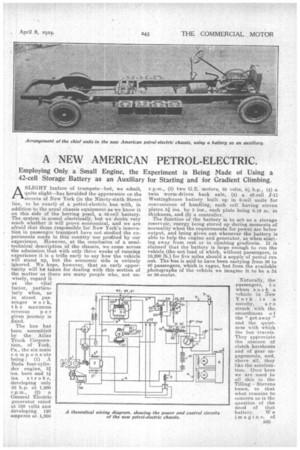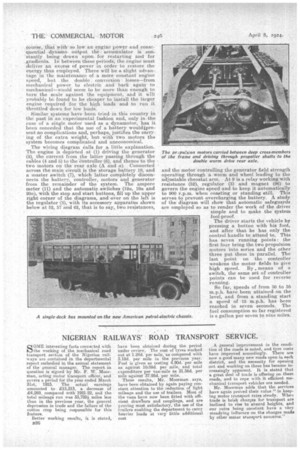A NEW AMERICAN PETROL-ELECTRIC.
Page 9

Page 10

If you've noticed an error in this article please click here to report it so we can fix it.
Employing Only a Small Engine, the Experiment is Being Made of Using a 42-cell Storage Battery as an Auxiliary for Starting and for Gradient Climbing.
ASLIGHT fanfare of trumpets—but, we admit, quite slight—has heralded the appearance on the streets of New York (in the Ninety-sixth Street line, to be exact) of a petrol-electric bus with, in addition to the usual chassis equipment as we know it on this side of the herring pond, a. 42-cell battery. The system • is..sound electrically, but we doubt very much whether it will prove economical, and we are afraid that those responsible for New York's innovation in passenger transport have not studied the experiments made in this country nor profited by our experience. However, at the conclusion of a semitechnical description of the chassis, we come across the admission that with only three weeks of running experience it is a trifle early to say how the vehicle will stand up, but the economic side is entirely ignored. We hope, however, that an early opportunity will be taken for dealing with this section of the matter as there are many people who, not unwisely, regard it as the vital factor, particularly when, as in street passenger w o r k, t h e maximum
revenue p e r given journey is fixed.
The bus has been assembled by the Atlas Truck Corporation, of York, Pa., the six main components being : (1) A Buda four-cylinder engine, 3t ins, bore and 1* ins, stroke, developing only 20 h. p . at 1,200 r.p.m., (2) a General Electric generator rated at 100 volts and developing 120 amperes at 1,200
r.p.M. , (3) two G.E. motors, 85 volts, (4) a twin worm-driven back axle, (5) a 42-cell j-11 Westinghouse battery built up in 6-cell units for convenience of handling, each cell having eleven plates 51 ins. by 5 ins., each plate being 0.19 in. in thickness, and (6) a controller. The function of the battery is to act as a storage reservoir,energy being stored up during moments of normality when the requirements for power are below output, and being given out whenever the battery is able to help the engine and generator, as when starting away from rest or in climbing gradients. It is claimed that the battery is large enough to run the vehicle (the net load of which, without passengers, is 10,200 lb.) for five miles should a supply of petrol run out. The bus is said to have been carrying from 30 to 40 passengers, which is vague, but from the available photographs of the vehicle we imagine it to be a 34 or 36-seater.
Naturally, the passengers, t o whom such a vehicle in IN
2 -224 York is a novelty, a r e
struck . with the smoothness o f the " get-away " and the quietness with which the bus travels. They appreciate the absence of clutch harshness and of gear engagements, and, above all, they like the acceleration. Over here we are used to all this in the Tilling Stevens buses, so that what remains to concern us is the question of the need of that battery. W e imagine, of course, that with so low an engine power and consequential dynamo output the. accumulator is constantly being drawn upon for restarting and for gradients. ln between these periods; the engine must deliver an excess of power in order to restore the energy thus employed. There will be a slight advantage in the maintenanee of a more constant engine speed, but the double conversion losses—from mechanical power to electric and back again to mechanical—would seem to be more than enough to turn the scale against the equipment, and it will probably be found to be cheaper to install the larger engine required for the high loads and to run it throttled down for low loads.
Similar systems have been tried in this country in the past in an experimental fashion and, only in ,the case of a single motor used as a dynamotor, has it been conceded that the use of a battery wcnaldipresent no complications and, perhaps, justifies the carry. ing of the extra weight, but with two motors the system becomes complicated and uneconomical.
The wiring diagram Calls for a little explanation. The engine is depicted at (1) driving the generator (2), the current from the latter passing through the cables (4 and 5) to the controller (6), and thence to the two motors on the rear axle (A and a). Connected across the main circuit is the storage battery 10, and a master switch (7), which latter completely disconnects the battery, controller, motors and generator from the remainder of the system. The ampere meter (11) and the automatic switches (12a' 19a and 20a), with the stop and start buttons, fill up the upper right corner of the diagrams, and•over on the left is the regulator (3), with its accessory apparatus shown below at 52, 57 and 62, that is to say, two resistances, and the motor controlling the generator field strength operating through a worm and wheel leading to the adjustable rheostat arm. At 9 is a relay working with resistance (52), regulator (3) and magnet (96) to govern the engine speed and to keep it automatically to 900 r.p.m. when coasting or standing still. This serves to prevent overcharging the battery. A study of the diagram will show that automatic safeguards are employed so as to render the work of the driver simple and to make the system fool-proof.
The driver starts the vehicle by pressing a button with his foot, and after that he has only the control handle to attend to. This has seven running points : the first four bring the two propulsion motors into series and the other three put them in parallel. The last point on the controller weakens the motor fields to give high speed. By „ means of a switch, the same set of controller points can be used for reverse running. • So far, speeds of from 30 to 35 m.p.h. have been attained on the level, and from a standing start a speed of 15 m.p.h. has been reached in seven seconds. The fuel consumption so far registered is a gallon per seven to nine miles.






























